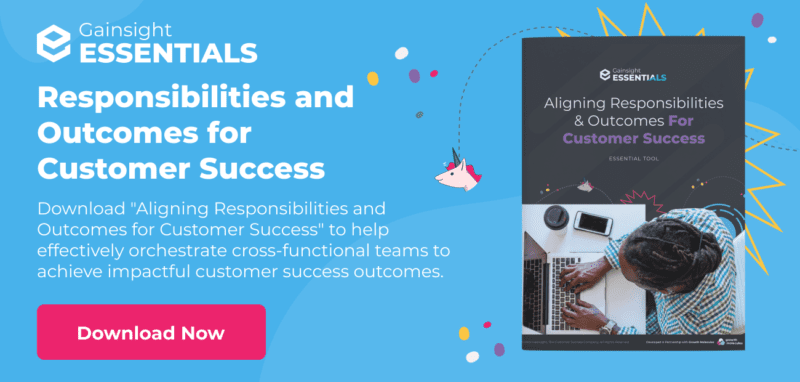For companies who are just getting started, or who are early in their customer success journey, a common challenge is alignment. Specifically, alignment becomes challenging in multiple ways, such as:
- Rallying everyone in an organization around what the value of customer success will be for the organization.
- Creating the understanding that customer success is not just the function of a single department.
- Adopting a long-term mindset about the impact customer success will make now, and the opportunities it will create for growth in the future.
In the latest session of our popular Customer Success Catapult webinar series, host Tim Van Lew talked through these challenges with Nikki Bishop, Vice President, Customer Success at Seeq.
It’s great to have everyone in your organization aligned and supporting the concept of customer success, but the path to getting there means different things for everyone. At the center of it all, is developing and fostering trust around what CS is, what it should be contributing to the business, and how its impact will be measured. Nikki’s strategy for developing trust around CS at Seeq is a good model for all of us to follow.
Customer success is a team sport
Seeq’s CS department consists of the following roles:
- Analytics Engineering which is similar to professional services.
- A Learning Team, which puts together educational content, focuses on onboarding, and supports upskilling of customers on the Seeq product.
- Customer Success Managers who are viewed as trusted advisors and customer advocates.
- Customer Success Operations which even early on was a key driver of scale and efficiency for CS motions.
While each role has a vital responsibility in the CS program, Nikki was quick to point out that the entire company needs to see itself as part of the CS team. In order for customer success to have a broad impact, it needs to be understood and adopted broadly across the entire organization.
All businesses are in the business of making their customers successful. That simple idea is unifying and shared throughout the company. Because customer success is a philosophy as much as it is a function, a new CS leader and their department won’t be successful unless it is integrated with other functions of the business.
Positioning customer success for cross-functional buy-in
One misstep companies make when introducing customer success into the organization is that they pitch it as a radical and new way of thinking. But in business, radical ideas can take a long time to rally around. Often, they are dismissed completely.
Another approach is showing the reality of what the organization is already doing that supports customer success. When Nikki started at Seeq, she quickly identified all the ways the company was growing and serving its customers effectively. That means the business was already applying customer success approaches in some capacity, without a formal customer success function.
Once you identify all the ways your company is already helping customers achieve outcomes, consider this simple question:
“What would be the impact on our business if we were to take all the great things we’re doing for our customers, standardize it and scale it?”
Getting cross-functional teams to connect CS with what they are already doing makes it much easier to get their buy-in on plans to do those things in a more systematic and efficient way.
The customer journey as your first big cross-functional project
Once you establish a common understanding of the improvements customer success can make to the business, you must chart a path to making it happen. In order to be prepared to scale, you must also create common action in support of a consistent customer journey. Having cross-functional peers contribute to documenting that journey means the difference between ideas that just get discussed and ideas that actually get done.
Get representatives in a room from every area of the business to map out the entire customer experience: from buying and contracting, to onboarding, as well as unplanned events like executive champion turnover. Opportunities for improvement will quickly become visible to everyone. Uncovering those problems together will make solving them much easier as a team.
Once you identify what needs to improve, be sure to task out the changes, so they actually occur. Over time, as things become more operationalized, you can then find ways to make them automated.
Find metrics the organization can rally around
Early on, it’s common for the CS department to have very little customer success data. After all, you’re just starting to form the function, and still learning what data points to pay attention to.
In the beginning, customer success reporting is more qualitative and focused on sharing customers’ stories. There is value in talking about the total number of customers, new use cases, and the impact your products are making on customers. But, those customer stories don’t create trends that help quantify the health of the business.
While you may not have foundational data to accurately calculate NRR, NPS, CSAT, churn rate, and other essential CS metrics, you still need to get started and show progress. Start working on those metrics sooner than you would expect. Even if you’re only surveying three customers, it gets you in the rhythm of reporting and gives you a baseline to build on.
Also, don’t hesitate to put placeholders for certain metrics into your reporting. It gives you an opportunity to convey why they are important, and explain that you’re collecting the necessary data to be able to calculate and share the metrics in a meaningful way.
Working together to create customer success at scale
Before long, colleagues across the organization will readily identify their role and impact on making customer success a driver of durable growth for the business. Just giving the rest of the organization insight into CS information is helpful. Pulling up reports of accounts up for renewal, looking at health scores and digging into customer sentiment will quickly help other teams understand where they need to make changes that add value back into the customer.
Alongside the virtuous loops of improvement from the rest of the team, your CSMs can maintain the functional role of being a trusted advisor and partner to your customers. When customers can see that they have an advocate within the company, and can understand how the rest of the organization is rallying to help them succeed with your product, you’ll naturally get your customer health, company health and KPIs like NRR all trending upward.

